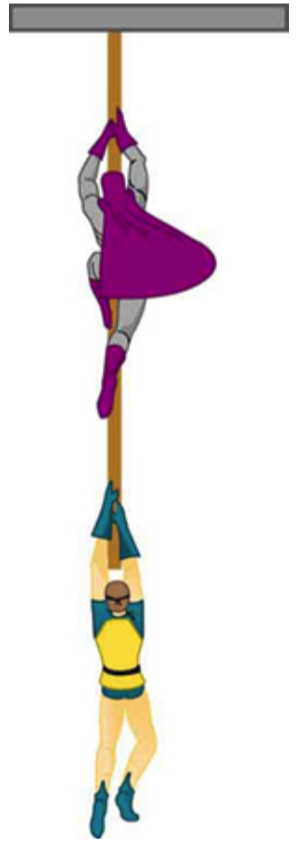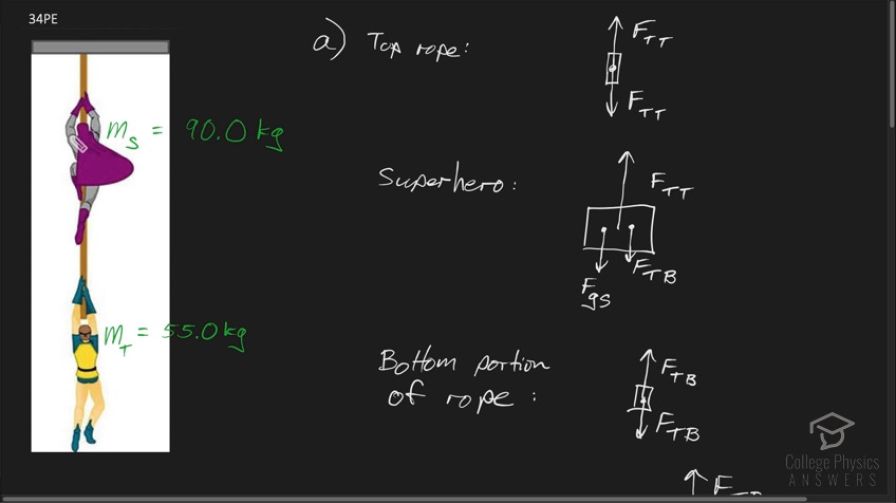Question
Figure 4.38 shows Superhero and Trusty Sidekick hanging motionless from a rope. Superhero’s mass is 90.0 kg, while Trusty Sidekick’s is 55.0 kg, and the mass of the rope is negligible. (a) Draw a free-body diagram of the situation showing all forces acting on Superhero, Trusty Sidekick, and the rope. (b) Find the tension in the rope above Superhero. (c) Find the tension in the rope between Superhero and Trusty Sidekick. Indicate on your free-body diagram the system of interest used to solve each part.

Final Answer
- See the video for freebody diagrams.
Solution video
OpenStax College Physics, Chapter 4, Problem 34 (Problems & Exercises)

vote with a rating of
votes with an average rating of
.
Calculator Screenshots
Video Transcript
This is College Physics Answers with Shaun Dychko. Our first job in this question is to show all the forces acting on each part of this picture. We have our superhero, which I will denote with subscript s and a trusty sidekick with subscript t. The superhero’s mass is 90 kilograms and the trusty sidekick has a mass of 55 kilograms. And we’re gonna draw a free body diagrams of the top portion of rope, which is just the portion here. And then we'll draw free body diagram of the superhero. And then a free body diagram of this portion of rope here is at the bottom portion. And then a free body diagram of the trusty sidekick. So that's four free body diagrams. So the top portion of rope has a tension force in the top going upwards. That's the force exerted by the ceiling on the rope. And then we have the same magnitude tension force on the top portion of rope directly downwards. I labeled them both the same because they have the same magnitude. And the free body diagram diagram for our superhero has a single force going upwards, which is this tension in the top portion of rope, and two forces down; one is the tension in the bottom portion of rope pulling down, and he also has the force of gravity on the superhero. So there’s two forces downwards. The bottom portion of rope has a tension in the bottom portion of rope upwards and downwards. And the trusty sidekick has only two forces on him; the tension in the bottom portion of rope upwards, and the force of gravity on the trusty sidekick downwards. So in part B. We're going to figure out what is this tension force in the top portion of rope. So consider both of these free body diagrams; one for the superhero and one for the trusty sidekick. We're going to create, you know Newton’s second law equations for each of them, howing that all the net forces are zero in both pictures. So in the first picture, we have the tension force at the top portion of rope directed upwards, so it’s positive. And then minus the tension in the bottom portion of rope pulling the superhero down. And then minus also the force of gravity on the superhero, which is the superhero’s mass times acceleration due to gravity. And all of that equals zero because the superhero is stationary and not accelerating. And for the second picture which we need because this equation one we can’t solve it, because there are two unknowns. We don't know the tension in the top portion of rope nor do we know the tension in the bottom portion of rope. So we only have a single equation with two unknowns. It means you need to look for a second equation in order to substitute for one of these unknowns with something that you do know. So in equation two we're gonna create that substitution. We're gonna say that the tension force in the bottom portion of rope directed upwards, minus the force of gravity on the trusty sidekick; mass of the trusty sidekick times g equals zero. And we can rearrange that for equation two version b, where we’ve added the force of gravity on the trusty sidekick to both sides. So it cancels on the left and we're left with force of tension on the bottom portion of rope is the force of gravity on the trusty sidekick. And so this is something we can plug-in into equation one. So equation one version b, I’ve re-written equation one, but I’ve written a substitution in red here where instead of f t b, I’ve written m t g in it’s place. And this is something that we know. And so now this is an equation with only one unknown and I will solve for it. So we'll add m t g and m s g to both sides. And also factor out the g, common factor g from these two terms. And we’re left with the force of tension in the top portion of rope is, gravitational field strength times the sum of the masses of the two good guys. So it’s 9.80 newtons per kilogram times 55 kilograms plus 90 kilograms, which is 1420 newtons when you have three significant figures. This is 9.80 here. So that answers part B, and then part C says, what is the force of tension in the bottom portion of rope? And we already said here in equation two version b that it’s the weight of the trusty sidekick. So calculate that weight by taking 55 kilograms times 9.8 newtons per kilogram, which is 539 newtons.
Comments
Will you explain the top rope diagram more? why is the down arrow FTT?
Hi blue, thank you for the question. Tension in a rope pulls any piece of rope in both directions along the rope with equal magnitudes. You can picture a particular point of the rope being "stretched" in both directions along the rope. That's what the top picture is trying to convey - a piece of rope is being pulled upwards due to the ceiling, and it's also being pulled downwards by the weight of the superheros. The resulting tension acts with equal magnitude in both directions on a piece of the rope. Since the magnitudes are the same I labeled them the same as FTT for force of tension on the top segment of rope.
All the best,
Shaun


